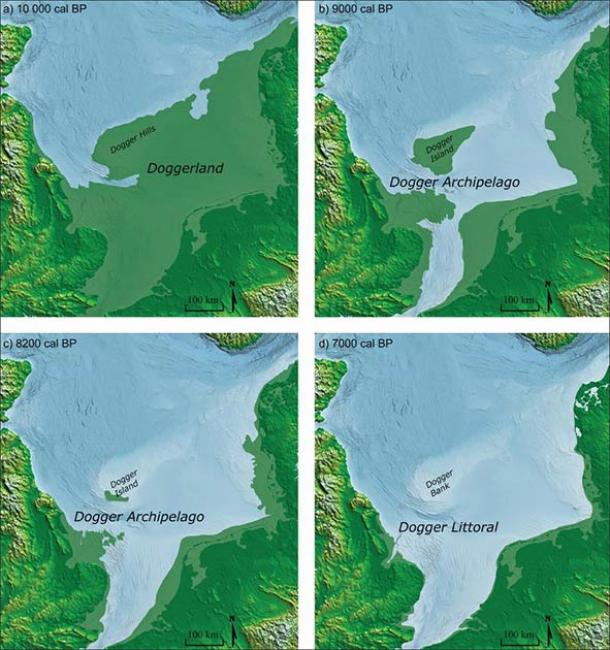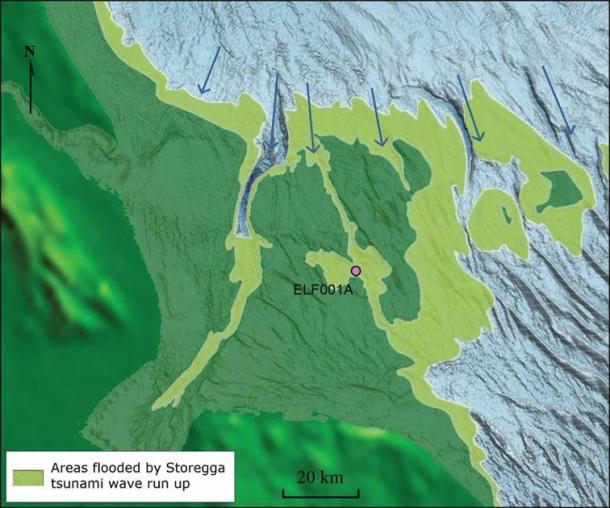Thousands of years ago, mainland Europe and the UK were attached by a landmass called Doggerland. A tsunami hit that land and it was believed for a time that almost all of the hunter-gatherers who were living there were lost in the natural disaster. However, a team of researchers have re-assessed the devastation caused by the Doggerland tsunami event which occurred 8,000 years ago and say that while it was catastrophic, some people and parts of the land survived.
The Shrinking of the ‘Atlantis of Britain’
Doggerland is located in the North Sea and estimates suggest it measured approximately 100,000 square miles (258,998 sq. km) when it was at its greatest extent. The discovery and dating of prehistoric animal bones and, to a lesser extent, human remains and artifacts, suggest that Doggerland was first inhabited around 10,000 BC. Stone Age hunter-gatherers inhabited the area and when Doggerland was complete they had the ability to trek between what is now Britain and mainland Europe.
Until this new study in Antiquity emerged, scientists believed that climate change and rising sea levels after the last ice age steadily diminished Doggerland. It was believed to have been a vast landmass, then an island, and finally it was consumed by the surrounding waters following the massive Storegga tsunami, which struck the North Sea coast of Britain and Doggerland about 8,000 years ago. However, a new analysis suggests that not all of the land was flooded – an archipelago survived.

North Sea coastline reconstructions for: a) Doggerland c. 10 000 cal BP; b) Dogger Archipelago c. 9000 cal BP; c) Dogger Archipelago c. 8200 cal BP; d) Dogger Littoral c. 7000 cal BP. (Image by M. Muru/ Walker et al.2020/ Antiquity Publications Ltd )
What Caused the Tsunami?
Previous research has concluded that the Storegga Event set off the tsunami that submerged much of Doggerland. The Storegga Event refers to a series of underwater landslides that took place off the Norwegian Atlantic coast 8,150 years ago. This event has been linked to numerous tsunamis in the North Atlantic Ocean and the Antiquity press release declares that the “resulting gigantic waves were a catastrophic natural disaster of a scale the region has not seen since.”
Before the new research paper was published, this devastating tsunami was believed to have been the reason why the already partially flooded Doggerland was finally submerged. But the new analysis of Doggerland’s topography and sediments by scientists from the UK and Estonia reveals that there is more to the story.
The researchers found that the tsunami that struck Doggerland was certainly devastating, and, as they wrote in their paper “must have been of considerable proportions.” They discovered that there was tsunami sediment over 40 km (24.85 miles) inland in southern Doggerland, but “the wave would have been concentrated in valleys whilst dense forests and hills may have protected other parts of the region. Furthermore, the uplands that would become Dogger bank may have also dissipated some of the wave’s energy.”

A sediment sample showing evidence for the Doggerland tsunami event. (Walker et al.2020/ Antiquity Publications Ltd )
Their results suggest at least part of Doggerland, and probably some of its inhabitants, survived the tsunami. The researchers’ paper explains “The broader landscape became increasingly fragmented by the formation of estuaries, inlets, and islands. From this period onwards—and certainly following the significant sea-level rise associated with the 8.2 ka event—it would be better to conceive of this landscape as the ‘Dogger Archipelago.’” They believe the archipelago survived for another millennia, but it finally succumbed to the rising sea levels that accompanied continued climate change.

Model showing the Storegga tsunami and run-up around the western sector of the southern North Sea at 8150 cal BP. (Image by M. Muru Walker et al.2020/ Antiquity Publications Ltd )
Survivors of the Devastating Doggerland Tsunami
Thousands of people could have died and/or seen their homes washed away in the Doggerland tsunami disaster. A previous study has shown that the Storegga tsunami hit sometime between October and December, which means the massive destruction of supplies, homes, and boats would have made that winter extremely difficult and perhaps unbearable for survivors. To make matter worse, the people were also dealing with the harshest conditions of the 8.2 ka ‘cold snap’ at the time.
The Doggerland inhabitants were in an unstable location due to the dramatic climate change, but for a time they had been living in a lush landscape that appeared when the glaciers receded following the ice age. It would have been a very attractive option for hunter-gatherers living in northwest Europe because of the abundant hunting and foraging opportunities there.
The researchers also believe that the people who survived the Doggerland tsunami incident could have played a key role in the region’s prehistory, and they may have even had an impact on the spread of farming across the area which has become Britain. They were living at a time when farmers were migrating into the region from continental Europe, which means that their homeland could have been a ‘staging ground’ for early farmers. However, the researchers also note that Doggerland may have been “an isolated region they never reached and hunter-gatherers flourished, or a unique mixing pot between the two groups.” More research could help in trying to sort out what life was actually like in the Dogger Archipelago.
Past and Future Disasters
The Antiquity press release suggests that the new research is not only an analysis of the past, but it may also help with “modern tsunami research anticipating similar future events in an increasingly developed North Sea.”
Professor Vince Gaffney, of the School of Archaeological and Forensic Sciences at the University of Bradford and one of the lead authors of the current paper, has mentioned before that the Doggerland tsunami story should be taken as a warning. He said, “The events leading up to the Storegga tsunami have many similarities to those of today. Climate is changing and this impacts on many aspects of society, especially in coastal locations.”
Now researchers are also beginning to worry that “the opportunity to investigate this landscape could be closing fast” because “There are proposals for massive development in the North Sea which could jeopardize future research.”
The study is to be published in Antiquity at https://doi.org/10.15184/aqy.2020.49
Top Image: People moving to higher ground in ‘Deluge’ by Ivan Aivazovsky. New research shows some people survived the devastating Doggerland tsunami event. Source: Public Domain
 RSS Feed
RSS Feed















 December 1st, 2020
December 1st, 2020  Awake Goy
Awake Goy  Posted in
Posted in  Tags:
Tags: 













